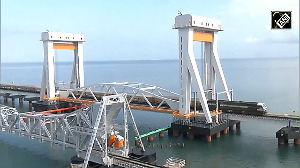About 24 years ago, I was in a house in a small village some distance from Udaipur in Rajasthan. A government functionary was explaining how an improved chulha (stove) worked -- they had installed one in the kitchen. At that time, India was waking up to forests being devastated.
It was believed then (wrongly, as it turned out) that the poor were primarily responsible for the devastation as they were cutting trees for wood to cook food. It was also understood that smoke from chulhas was carcinogenic and that women were worst-hit by this pollution. The answer was to design improved chulhas for better combustion and with a chimney.
The woman-owner of this improved stove was cooking the day's meal. I asked if she was happy with what science and government had donated to her. Her answer was simple: "Looks good, does not work. I modified it."
Her problem was that, in this area, women cooked gruel in big utensils. Her homemade original stove was suited to her diet and her utensils. The improved chulha, with its small opening to streamline the fire, was of little use. When the chulha was designed, nobody asked her what she needed. Nobody explained to her the laws of thermodynamics, so that she could fathom why the chulha looked and worked as it did.
And nobody was there who could repair or reshape her chulha. She had simply broken the opening to suit her needs. Carefully calculated combustion in the laboratory of the local university and delivered through a government programme had turned to hot air.
I learnt my most valuable lesson that day. Designing technologies for diversity and affordability is much more complex than sending a man to the moon.
But why am I discussing this moment of development history? Well, chulhas are back. This time, on the world stage. Science has discovered black carbon -- soot -- is a key contributor to climate change; these particles warm the air; when they settle on glaciers, the latter melt. So now, soot from the chulhas poor households use -- burning wood, twigs and cowdung-stands indicted for climate change.
A Bill has been introduced in the US Congress which requires the country's Environment Protection Agency to regulate black carbon and direct aid to black-carbon-reduction projects abroad, including improved chulhas in some 20 million homes.
I don't dispute the science of black carbon. There is no reason to argue nothing should be done to improve and substitute the polluting and noxious chulhas of the poorest. The problem is not in the intent. The problem is in the 'why' and the 'what needs to be done'.
Today, the international community views these chulhas as an easy solution: 18 per cent of the problem comes from these implements, so replace them. But their plan to reduce pollution here only helps create space for cars and power stations to continue to pollute.
Also, the international community is today wrongly equating different types of emission. There is the 'survival emission' of poor people with no alternative but to walk long distances to collect firewood, sweep the forest floor for leaves and twigs and do backbreaking work to collect and dry cowdung, all for some 'oil' to cook their food.
This 'survival' emission is being equated with the 'luxury' emissions of you and I, who drive to work and live in air-conditioned comfort.
This distinction is necessary. For policy and action. Otherwise, an important opportunity -- provided to us by the poorest in the world -- to reduce emissions in the future will be lost. Let us be clear: The poorest of the world, who use chulhas that pollute the environment because they cannot afford commercial fossil fuel, provide us the only real space today to avert climate change.
According to the 2006 International Energy Agency data, the bulk of what is classified as renewable energy, (around 80 per cent) comes from biomass burning, from the very chulhas of poor families. It is these families, living on the margins of survival, already vulnerable to climate change impacts, who are in the renewable energy net.
The energy trajectory is such that these families, when they move out of poverty, will also move out of cooking on this biomass chulha. They will walk up the fossil fuel stairway to liquefied petroleum gas. Every time they move away, as they must, one less family will be using renewable energy. One more, like you and I, will begin polluting with long-life greenhouse gas emissions.
The difference is that black soot pollutes locally -- it literally kills the women who are cooking -- but has a relatively short life in the atmosphere. So, unlike carbon dioxide, it disappears in a few weeks.
The poorest, therefore, provide the world the perfect opportunity to leapfrog -- they can move from using renewable energy which is currently polluting, to using more renewable energy, but which is clean for them and the world. It is this objective that must drive our efforts, not a plan to pick on the poorest so that we can continue to pollute.
This is not easy. It will not be cheap. Science must now invent that cheap, biomass-based chulha that can be sold, distributed and used in millions of diverse households across the world. Are we up to the challenge?







 © 2025
© 2025